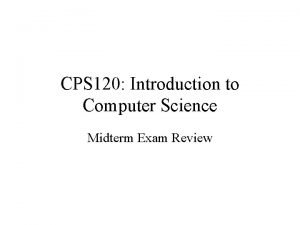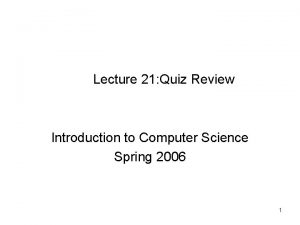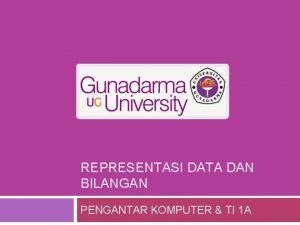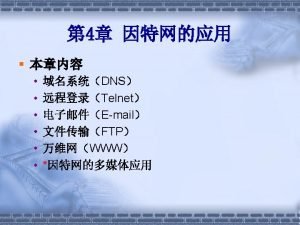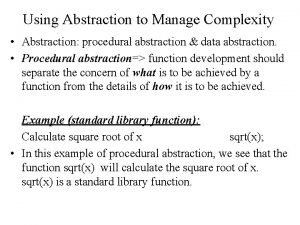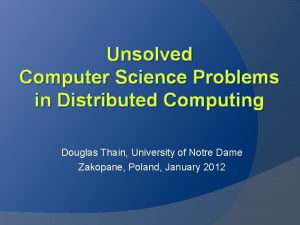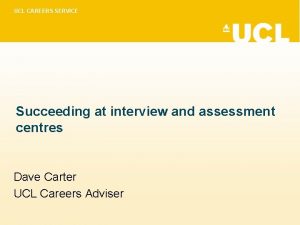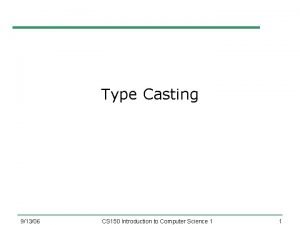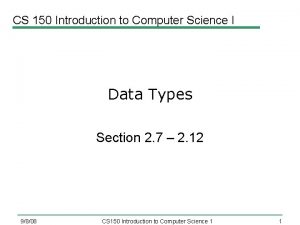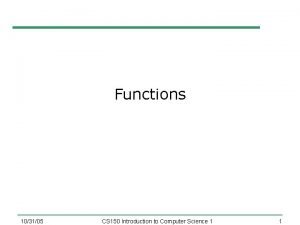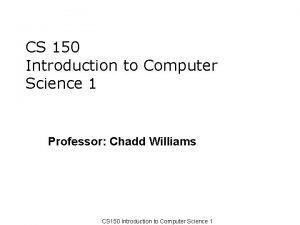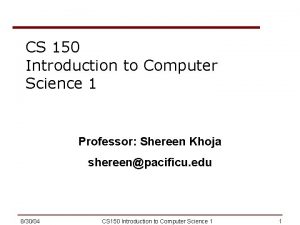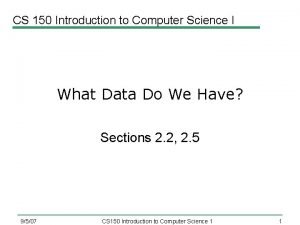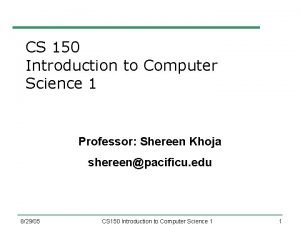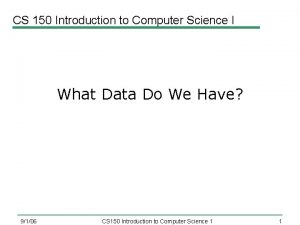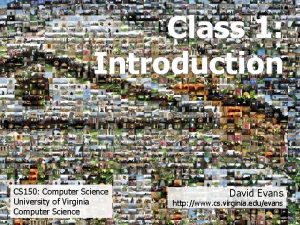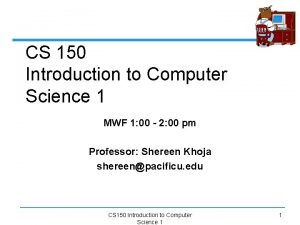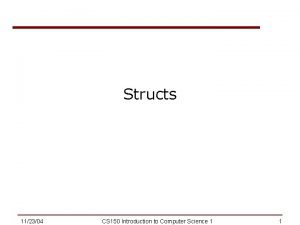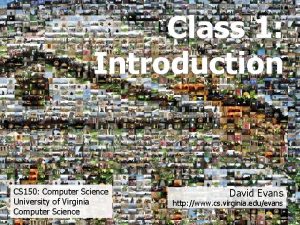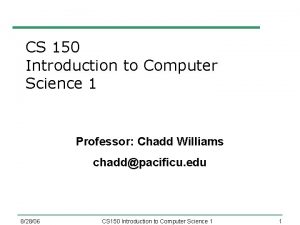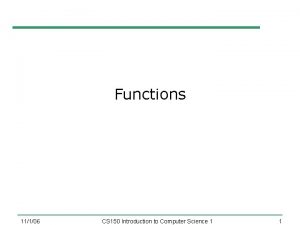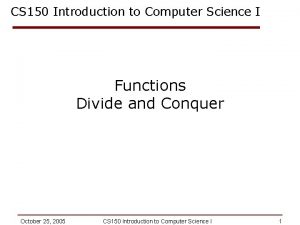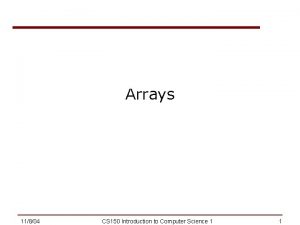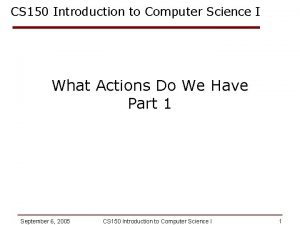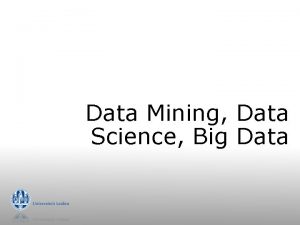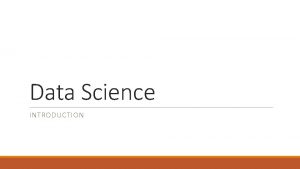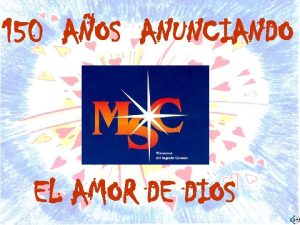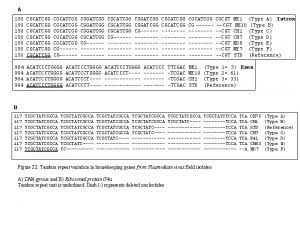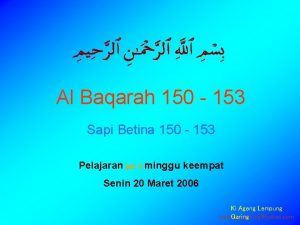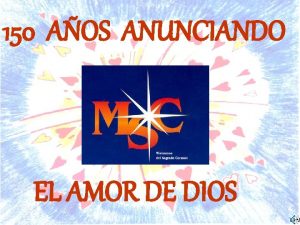CS 150 Introduction to Computer Science I Data




























- Slides: 28

CS 150 Introduction to Computer Science I Data Types 9/6/06 CS 150 Introduction to Computer Science 1 1

Today Last we covered o main function o cout object o How data that is used by a program can be declared and stored Today we will o 9/6/06 Investigate the various types of data that C++ can handle CS 150 Introduction to Computer Science 1 2

Declaration Statements Examples of declaration statements const double PI = 3. 14; const double RADIUS = 5. 4; double area; double circ; With the above statements we are declaring four things o PI to store the value of Pi that never changes o RADIUS to store the value of radius that never changes o area to store the area of the circle o circ to store the circumference of the circle 9/6/06 CS 150 Introduction to Computer Science 1 3

Declaration Statements Variable declarations o Allocate space for data to be used in the program o The data can be changed double area; double circ; Constant declaration o Allocate space for data that cannot be changed const double PI = 3. 14; const double RADIUS = 5. 4; 9/6/06 CS 150 Introduction to Computer Science 1 4

Variable Declaration Variables are declared by stating o Type of data (data type) o Name to identify the variable (identifier) o Semicolon (; ) data-type identifier; double area; 9/6/06 CS 150 Introduction to Computer Science 1 5

Variable Declaration If there is more than one variable of a single data type then you o State the data type o List the variable identifiers (names) separated by commas o Semicolon data-type identifier 1, identifier 2; double area, circ; 9/6/06 CS 150 Introduction to Computer Science 1 6

Identifiers Programmer-defined names that represent some element of a program C++ does place limits on what names you can call your variables Rules 1. Identifiers must begin with a letter or an underscore 2. Identifiers must consist of letters, numbers and underscore, nothing else 3. Identifiers cannot be a reserved keyword 9/6/06 CS 150 Introduction to Computer Science 1 7

Reserved Keywords These are words that are reserved by C++ to implement various features Examples of keywords that we have seen so far are int, double, const, return A list of C++ keywords can be found on page 45 of your textbook 9/6/06 CS 150 Introduction to Computer Science 1 8

Identifiers are case sensitive o int num 1; o int Num 1; o num 1 and Num 1 are different variables You should always try to use meaningful variable names If you have a variable that represents the width, then call it width not w 9/6/06 CS 150 Introduction to Computer Science 1 9

Identifiers Q 4. 1 Which of the following declarations are invalid and why? a. char Letter 1; b. char 1 letter; c. double inches, kms; d. double inches*num; e. int joe’s; f. Int cent_per_inch; g. double two-dimensional; h. char hello; i. int return; j. size int; 9/6/06 CS 150 Introduction to Computer Science 1 10

Data types o C++ can store many different types of data o A data type also defines what operations can be performed on data of that type o We will be looking at § § § 9/6/06 Integer numbers Characters Strings Floating-point numbers Booleans CS 150 Introduction to Computer Science 1 11

Integers The main integer data type is int The int data type is used to store integer numbers, both positive and negative ints are finite (why? ), i. e. they have a limited range that is implementation dependent Examples of ints are: 123, -23, 0, 2352 An int without a sign (+ or - ) is assumed to be positive 2, 353 is not an int, 2353 is an int What operations can be performed on integers? 9/6/06 CS 150 Introduction to Computer Science 1 12

Integer Data Types There are five integer data types, each with a different range and a different size Range of data types is listed on page 48 9/6/06 CS 150 Introduction to Computer Science 1 13

char The char data type is used to store single characters (letters, digits, special characters) chars are usually 1 -byte long Characters are stored as integers The most common method for encoding characters is ASCII Character constants are enclosed in single quotes Examples of character constants are: ‘A’, ‘a’, ‘*’, ‘ 2’, ‘$’ 9/6/06 CS 150 Introduction to Computer Science 1 14

Program 4. 1 #include "stdafx. h" #include <iostream> using namespace std; int main() { char letter; letter = 65; cout << letter << endl; letter = 66; cout << letter << endl; return 0; } 9/6/06 CS 150 Introduction to Computer Science 1 15

Program 4. 2 #include "stdafx. h" #include <iostream> using namespace std; int main() { char letter; letter = 'A'; cout << letter << endl; letter = 'B'; cout << letter << endl; return 0; } 9/6/06 CS 150 Introduction to Computer Science 1 16

char Character constants can only hold a single character String constants are used to store a series of characters To indicate the end of a string, a null terminator is used 9/6/06 CS 150 Introduction to Computer Science 1 17

Questions Q 4. 2 How are the character ‘A’ and the string constant “A” stored in memory? Q 4. 3 Is the escape character n a character or a string? Q 4. 4 How do we declare a char variable and assign it a value? 9/6/06 CS 150 Introduction to Computer Science 1 18

string Class string is the data type used to store more than one character Not built into C++ but provided by standard C++ Need to include the preprocessor directive o 9/6/06 #include <string> CS 150 Introduction to Computer Science 1 19

string Questions Q 4. 5 How do we declare a variable of type string? Q 4. 6 How do we assign a value to the variable? Q 4. 7 How do we output a string constant and a string variable? What is output? 9/6/06 CS 150 Introduction to Computer Science 1 20

Floating-Point Data Types The float, double, and long double data types are used to store floating-point numbers, both positive and negative Floating-point numbers can contain fractional parts Computers store floating-point numbers in a manner similar to scientific notation Computers represent floating-point numbers using E notation 9/6/06 CS 150 Introduction to Computer Science 1 21

Floating-Point Data Types float, double, and long double are finite Examples of floating-point numbers are: 1. 0, -2. 3, -. 3, 12 E 5, -1 E-2, 1. 4 e+8 2, 353. 99 is not a double, 2353. 99 is a double 9/6/06 CS 150 Introduction to Computer Science 1 22

Examples Remember, the format for declaring variables is: o data-type identifier; You can declare variables of the different data types as follows o int num 1; o double num 2; o char letter; 9/6/06 CS 150 Introduction to Computer Science 1 23

How to Choose a Data Type Ask yourself the following questions o What are the largest and smallest numbers that may be stored? o How much memory does the variable use? o Is the variable signed (positive and negative)? o How many decimal places of precision does the variable need? 9/6/06 CS 150 Introduction to Computer Science 1 24

Variable Sizes On my machine the sizes are 9/6/06 CS 150 Introduction to Computer Science 1 25

Variable Size Program #include "stdafx. h" #include <iostream> using namespace std; int main() { cout << "The size of an int is: tt" << sizeof(int) << " bytes. n"; cout << "The size of a short int is: t" << sizeof(short) << " bytes. n"; cout << "The size of a long int is: t" << sizeof(long) << " bytes. n"; cout << "The size of a char is: tt" << sizeof(char) << " bytes. n"; cout << "The size of a float is: tt" << sizeof(float) << " bytes. n"; cout << "The size of a double is: t" << sizeof(double) << " bytes. n"; return 0; } 9/6/06 CS 150 Introduction to Computer Science 1 26

Variable Ranges Type Size Values int 4 bytes – 2, 147, 483, 648 to 2, 147, 483, 647 short int 2 bytes – 32, 768 to 32, 767 long int 4 bytes – 2, 147, 483, 648 to 2, 147, 483, 647 unsigned int 4 bytes 0 to 4, 294, 967, 295 Char 1 byte 256 character values float 4 bytes 1. 2 e– 38 to 3. 4 e 38 double 8 bytes 2. 2 e– 308 to 1. 8 e 308 9/6/06 CS 150 Introduction to Computer Science 1 27

Summary In today’s lecture we covered o Identifiers o Data types o How data that is used by a program can be declared and stored We have covered p. 45 - 63 of your textbook 9/6/06 CS 150 Introduction to Computer Science 1 28
 What is your favorite lesson
What is your favorite lesson Science fusion introduction to science and technology
Science fusion introduction to science and technology Introduction to computer science midterm exam
Introduction to computer science midterm exam Introduction to computer science midterm exam test
Introduction to computer science midterm exam test C++ code
C++ code Python programming an introduction to computer science
Python programming an introduction to computer science Data representation computer science
Data representation computer science 150 opening ascii mode data connection.
150 opening ascii mode data connection. Introduction to data warehouse
Introduction to data warehouse Social science vs natural science
Social science vs natural science Main branches of science
Main branches of science Natural and physical science
Natural and physical science Applied science vs pure science
Applied science vs pure science Anthropology vs sociology
Anthropology vs sociology Why environmental science is an interdisciplinary science
Why environmental science is an interdisciplinary science Windcube lidar
Windcube lidar Soft science definition
Soft science definition Gcse computer science wjec
Gcse computer science wjec University of phoenix computer science
University of phoenix computer science How many fields in computer science
How many fields in computer science Procedural abstraction example
Procedural abstraction example Unsolved problems in computer science
Unsolved problems in computer science University of bridgeport computer science
University of bridgeport computer science Bridgeport engineering department
Bridgeport engineering department Apcsp sequencing
Apcsp sequencing Computer science ucl
Computer science ucl Ucl careers service
Ucl careers service Casting computer science
Casting computer science Only one student failed in mathematics fol
Only one student failed in mathematics fol


